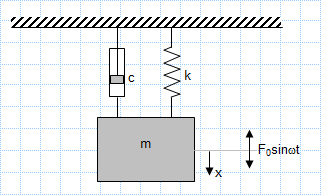Forced Vibration of a single degree of freedom system.xls

Description
Calculate an impact factor applicable to forced vibration of a single degree of freedom.
For optimum viewing double-click to maximise
Calculation Reference
Schaum's Mechanical Vibrations
| Find on Amazon.com | Find on Amazon.co.uk | Find on Amazon.fr | Find on Amazon.de | Find on Amazon.ca |
'Forced Vibration of a Single Degree of Freedom System.xls' is an Excel spreadsheet file used to analyze and calculate the response of a single degree of freedom (SDOF) system subjected to forced vibration. A single degree of freedom system represents the simplest form of a dynamic system, having only one independent coordinate (usually displacement) to describe its motion.
Forced vibration occurs when an external force is applied to a system, causing it to vibrate. The external force could be harmonic (sinusoidal) or any other time-varying function. The response of the system depends on its natural frequency, damping, and the characteristics of the applied force.
In an SDOF system, the governing equation of motion is given by:
m * x''(t) + c * x'(t) + k * x(t) = F(t)
where:
- m is the mass of the system
- x(t) is the displacement as a function of time
- x'(t) and x''(t) are the first and second time derivatives of x(t), representing velocity and acceleration, respectively
- c is the damping coefficient
- k is the stiffness of the system
- F(t) is the external force applied to the system as a function of time
In an Excel spreadsheet, one could model the behavior of an SDOF system under forced vibration by defining the system parameters (mass, damping, stiffness), specifying the forcing function F(t), and solving the equation of motion for the displacement x(t). The spreadsheet may use numerical methods, such as the finite difference method or the Runge-Kutta method, to solve the differential equation.
By adjusting the input parameters, the user can analyze the behavior of the system under different conditions and explore the effects of various factors, such as damping and forcing function characteristics, on the system's response.
Calculation Preview
Full download access to any calculation is available to users with a paid or awarded subscription (XLC Pro).
Subscriptions are free to contributors to the site, alternatively they can be purchased.
Click here for information on subscriptions.

